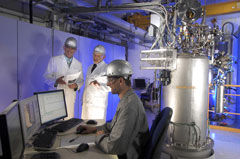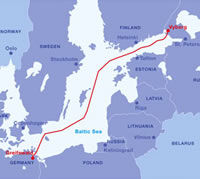Bayer expands carbon nanotube capacity
Investment boosts widespread industrial use of Baytubes®
Bayer MaterialScience AG is opening a second production facility for Baytubes®, its carbon nanotubes, at H.C. Starck GmbH in the town of Laufenburg on the German-Swiss border. The new facility has an annual capacity of 30 metric tons. Together with the pilot production plant for Baytubes® already located at the site, this now gives Bayer MaterialScience a total annual capacity of 60 metric tons in Laufenburg.

The control room of the new Baytubes ® production facility showing the top of the fluidized bed reactor.
Bayer MaterialScience AG
Estimates put the market potential for carbon nanotubes (CNT) in the coming years at several thousand metric tons per year. The main disadvantages of CNT production processes to date have been the high costs of synthesis and the relatively large quantities of unwanted impurities in the product. These two problems have prevented the widespread industrial use of carbon nanotubes. Thanks to a special new synthesis process, Bayer MaterialScience is one of the few manufacturers able to offer commercially relevant quantities of CNT with consistent material purities well above the 95 percent mark.
The Laufenburg location has a number of advantages for Baytubes® production. Firstly, the production of refractory metals, engineering ceramics and electronic chemicals, H.C. Starck has the necessary technical and logistics setup - for example, in terms of production facilities, energy and gas supplies and waste gas purification. Secondly, Bayer MaterialScience benefits from H.C. Starck's many years of expertise in processing technology and systems design for high-temperature gas phase processes.
In the medium term, Bayer MaterialScience is planning to build a large-scale Baytubes® production facility in Germany with an annual capacity of 3,000 metric tons.
Other news from the department manufacturing
Most read news
More news from our other portals
See the theme worlds for related content
Topic world Synthesis
Chemical synthesis is at the heart of modern chemistry and enables the targeted production of molecules with specific properties. By combining starting materials in defined reaction conditions, chemists can create a wide range of compounds, from simple molecules to complex active ingredients.

Topic world Synthesis
Chemical synthesis is at the heart of modern chemistry and enables the targeted production of molecules with specific properties. By combining starting materials in defined reaction conditions, chemists can create a wide range of compounds, from simple molecules to complex active ingredients.





























































